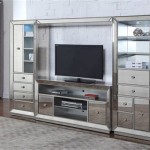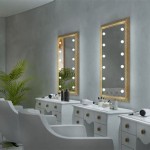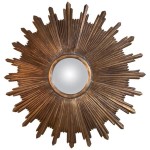DIY Nautical Rope Mirror: A Step-by-Step Guide
The nautical aesthetic, evoking images of serene seascapes and maritime adventures, can be seamlessly integrated into home decor. A DIY nautical rope mirror is a project that allows one to add a touch of coastal charm to any room. This project combines readily available materials with relatively simple techniques, resulting in a unique and personalized piece. The following guide outlines the necessary steps and considerations for creating a visually appealing and structurally sound nautical rope mirror.
Materials and Tools
The successful completion of this project relies on gathering the appropriate materials and tools beforehand. The selection of materials directly impacts the final appearance and durability of the mirror.
First, a mirror is required. The size and shape of the mirror are entirely customizable, allowing for flexibility in design. Round mirrors, square mirrors, and rectangular mirrors are all viable options. Consider the dimensions of the space where the mirror will be placed when determining the optimal size. The mirror should be thoroughly cleaned and free of any streaks or smudges before proceeding.
Next, nautical rope is essential. Manila rope is a popular choice due to its rustic texture and authentic nautical appearance. However, other types of rope, such as sisal rope or synthetic rope, can also be used. The diameter of the rope is a matter of personal preference; thicker rope creates a more substantial, bolder look, while thinner rope offers a more delicate and refined aesthetic. Measure the circumference of the mirror to determine the total length of rope needed, adding extra length for knots and potential adjustments. It is generally advisable to purchase more rope than initially estimated to account for errors or design modifications.
Adhesive is crucial for securely attaching the rope to the mirror. A strong adhesive specifically designed for bonding rope to glass is recommended. Construction adhesive, epoxy, or a high-strength craft glue are all suitable options. Ensure the adhesive is waterproof or water-resistant, especially if the mirror will be placed in a humid environment such as a bathroom. Read the adhesive manufacturer’s instructions carefully regarding application techniques and curing times.
Additional materials and tools include a measuring tape, scissors or a sharp knife, a hot glue gun (optional, for securing rope ends), sandpaper (optional, for preparing the mirror surface), a pencil or marker, painter’s tape, and safety gloves. The painter’s tape can be used to create a guide for applying the rope in a straight line around the mirror, while the safety gloves protect hands from adhesive and potential rope splinters.
Step-by-Step Construction Process
The construction process involves several stages, from preparing the mirror to securing the rope. Each step should be executed with precision to ensure a professional-looking finished product.
First, prepare the mirror surface. While not always necessary, lightly sanding the back of the mirror where the rope will be attached can improve adhesion. Use fine-grit sandpaper and gently roughen the surface. Clean the sanded area with a clean cloth and rubbing alcohol to remove any dust or debris. This step is particularly important if the mirror has a smooth, non-porous backing.
Next, measure and mark the desired placement of the rope on the mirror. Use a measuring tape and a pencil or marker to create guidelines. For a simple rope border, mark a line approximately one to two inches from the edge of the mirror. Painter’s tape can be applied along these lines to create a clean and even edge. This ensures that the rope is applied in a straight and consistent manner.
Apply the adhesive to the back of the mirror within the marked area. Follow the adhesive manufacturer's instructions for application. Apply a generous and even layer of adhesive, ensuring that it covers the entire area where the rope will be attached. Avoid applying too much adhesive, as this can result in excess glue seeping out from under the rope. Use a craft stick or a similar tool to spread the adhesive evenly.
Carefully attach the rope to the mirror, pressing it firmly into the adhesive. Start at one point and work your way around the mirror, following the guidelines created with the painter’s tape. Ensure that the rope is tightly pressed against the adhesive and that there are no gaps or loose sections. If using a thicker rope, it may be necessary to apply additional adhesive as you go to ensure a secure bond. Maintain consistent pressure on the rope until the adhesive begins to set.
Once the initial layer of rope is secured, allow the adhesive to cure according to the manufacturer’s instructions. This typically takes several hours or overnight. Avoid moving or disturbing the mirror during the curing process. After the adhesive is fully cured, remove the painter’s tape and inspect the rope attachment. If any sections of the rope are loose or poorly attached, apply additional adhesive and secure them with clamps or weights until the adhesive sets.
Finally, finish the rope ends. The ends of the rope can be finished in several ways, depending on the desired aesthetic. One option is to simply cut the rope and secure the ends with hot glue to prevent fraying. Another option is to create a decorative knot at the point where the rope ends meet. A common knot for this purpose is a figure-eight knot or a square knot. Secure the knot with adhesive to prevent it from unraveling. Alternatively, the rope ends can be overlapped and wrapped with twine or smaller rope for a more textured look.
Design Variations and Enhancements
Beyond the basic construction process, numerous design variations and enhancements can be incorporated to personalize the nautical rope mirror. Experimentation with different materials, techniques, and decorative elements allows for a unique and customized piece.
Consider incorporating additional nautical elements. Seashells, starfish, and small pieces of driftwood can be glued onto the rope or the mirror surface to enhance the coastal theme. These elements can be arranged randomly or in a more structured pattern, depending on the desired aesthetic. Remember to use a strong adhesive that is suitable for bonding these materials to glass and rope.
Experiment with different rope arrangements. Instead of a single layer of rope, consider wrapping multiple layers of rope around the mirror. This creates a thicker and more textured border. Different colors of rope can also be used to create a striped or patterned effect. Alternatively, the rope can be braided or woven before being attached to the mirror, adding visual interest and complexity. The braiding process can be as simple as a three-strand braid or as complex as a multi-strand plait.
Explore different knotting techniques. Beyond simply securing the rope ends, incorporating decorative knots throughout the design can add a distinctive nautical touch. Learn to tie various nautical knots, such as the monkey fist knot, the bowline knot, or the clove hitch knot. These knots can be strategically placed around the mirror to create focal points and add visual interest. Consider the size and shape of the knots when determining their placement, ensuring that they complement the overall design of the mirror.
In conclusion, creating a DIY nautical rope mirror is a rewarding project that adds a touch of coastal charm to any space. By carefully selecting materials, meticulously following the construction process, and exploring various design variations, one can create a unique and personalized piece that reflects individual style and creativity. The result is not merely a functional mirror but a decorative art object that evokes the spirit of the sea.

Nautical Rope Mirrors The Lilypad Cottage

Diy Rope Mirror Tutorial Nautical Style Bathroom Southern Revivals

Diy Nautical Rope Mirror Make It Fun Blog

Diy Nautical Rope Mirror Artsy Rule

Diy Nautical Rope Mirror Make It Fun Blog

Nautical Rope Mirrors The Lilypad Cottage

How To Make A Rope Mirror Ropes Direct

Diy Nautical Rope Mirror Artsy Rule

Diy Coastal Rope Mirror

Diy Nautical Rope Mirror How To Make Rounded Or Square








